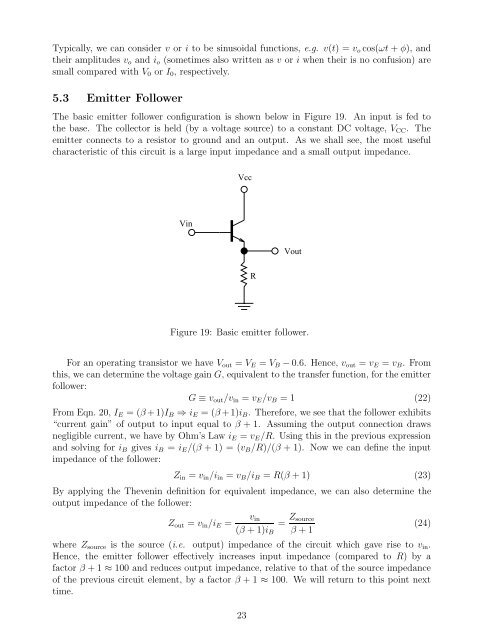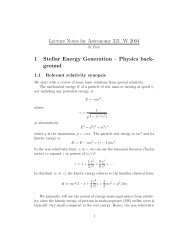Lecture Notes for Analog Electronics - The Electronic Universe ...
Lecture Notes for Analog Electronics - The Electronic Universe ...
Lecture Notes for Analog Electronics - The Electronic Universe ...
You also want an ePaper? Increase the reach of your titles
YUMPU automatically turns print PDFs into web optimized ePapers that Google loves.
Typically, we can consider v or i to be sinusoidal functions, e.g. v(t) =vocos(ωt + φ), and<br />
their amplitudes vo and io (sometimes also written as v or i when their is no confusion) are<br />
small compared with V0 or I0, respectively.<br />
5.3 Emitter Follower<br />
<strong>The</strong> basic emitter follower configuration is shown below in Figure 19. An input is fed to<br />
the base. <strong>The</strong> collector is held (by a voltage source) to a constant DC voltage, VCC. <strong>The</strong><br />
emitter connects to a resistor to ground and an output. As we shall see, the most useful<br />
characteristic of this circuit is a large input impedance and a small output impedance.<br />
Vin<br />
Vcc<br />
R<br />
Vout<br />
Figure 19: Basic emitter follower.<br />
For an operating transistor we have Vout = VE = VB − 0.6. Hence, vout = vE = vB. From<br />
this, we can determine the voltage gain G, equivalent to the transfer function, <strong>for</strong> the emitter<br />
follower:<br />
G ≡ vout/vin = vE/vB = 1 (22)<br />
From Eqn. 20, IE =(β+1)IB⇒iE =(β+1)iB. <strong>The</strong>re<strong>for</strong>e, we see that the follower exhibits<br />
“current gain” of output to input equal to β + 1. Assuming the output connection draws<br />
negligible current, we have by Ohm’s Law iE = vE/R. Using this in the previous expression<br />
and solving <strong>for</strong> iB gives iB = iE/(β +1)=(vB/R)/(β + 1). Now we can define the input<br />
impedance of the follower:<br />
Zin = vin/iin = vB/iB = R(β + 1) (23)<br />
By applying the <strong>The</strong>venin definition <strong>for</strong> equivalent impedance, we can also determine the<br />
output impedance of the follower:<br />
Zout = vin/iE = =<br />
(β +1)iB<br />
Zsource<br />
(24)<br />
β +1<br />
where Zsource is the source (i.e. output) impedance of the circuit which gave rise to vin.<br />
Hence, the emitter follower effectively increases input impedance (compared to R) bya<br />
factor β +1≈100 and reduces output impedance, relative to that of the source impedance<br />
of the previous circuit element, by a factor β +1≈100. We will return to this point next<br />
time.<br />
23<br />
vin













